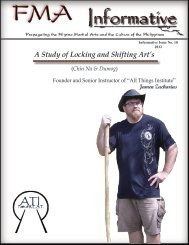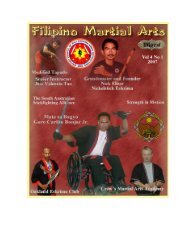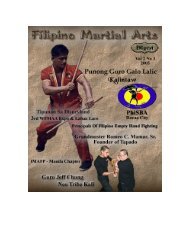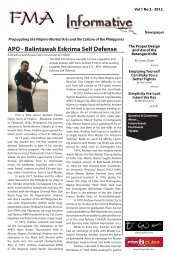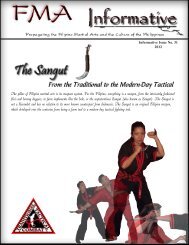Tournaments - FMA Informative
Tournaments - FMA Informative
Tournaments - FMA Informative
You also want an ePaper? Increase the reach of your titles
YUMPU automatically turns print PDFs into web optimized ePapers that Google loves.
The student learns to look at the enemy without flinching, blinking, or turning the<br />
focus of one’s vision to the enemy’s fist, hand or weapon, even in the middle of a flurry<br />
of offensive strikes. “You have to look at the enemy straight on, dead center, and rely on<br />
peripheral vision to see the strikes,” says Tabimina. “That way, no matter which direction<br />
the strike comes, you’ll see it. The moment you blink or shift your focus onto your<br />
enemy’s hands or weapon, you’re done for. A single distraction or improper focus can<br />
make a life and death difference.”<br />
Balintawak also involves keeping in step with one’s opponent and maintaining the<br />
Balintawak fighter’s in-your-face fighting range. Tabimina teaches students to dominate<br />
and control the fight by keeping in close range, whether one is moving back or moving<br />
forward. A Balintawak sparring session looks like cha-cha from the outside, with fighters<br />
moving back and forward in a synchronized way. The fighter who breaks the rhythm,<br />
either by failing to do the proper footwork or failing to keep the right range, loses.<br />
And the fact that most fighters are not comfortable in close range is probably one<br />
reason for Balintawak’s fearsome reputation.<br />
“It’s very rare that a fighter can fight close range,” says Tabimina. “The natural<br />
instinct is to move away from a threat. So many fighters will try to stay in the middle or<br />
longer range during a fight. They’re simply uncomfortable being in such close range with<br />
an enemy so their natural instinct is to move back. Once such a fighter moves back, a<br />
Balintawak fighter will take advantage of it and move in. By moving in and controlling<br />
the range, the Balintawak fighter can unbalance an opponent, discomfort, and bring him<br />
down.”<br />
According to Tabimina, one of the phrases used by Bacon with his students is<br />
“Simhuta ko, dong,” which is Cebuano for “Smell me, boy!” This simply means a<br />
Balintawak fighter relies on virtually pure sensory inputs and reactions. An enemy<br />
moves, and the good Balintawak fighter reacts quickly and effectively.<br />
“This doesn’t mean any reaction will do,” Tabimina<br />
cautions. “The reaction must be a productive one. And it should<br />
be automatic. Zero-mind. An unproductive, improper or delayed<br />
reaction can be deadly. Since you are fighting close range, any<br />
extra, unnecessary movement, the closest gap or pause in your<br />
reaction will make a difference in the fight’s outcome. An<br />
unproductive movement of the feet can leave you<br />
unbalanced, so the Balintawak fighter can use that against<br />
you. An unproductive movement of your arm can be used<br />
against you, too. In close-ranged fighting, more things can<br />
happen. Balintawak has only 12 basic strikes, but at close<br />
range, the combinations are almost infinite, and an<br />
opponent’s reactionary gap can be his downfall.”<br />
As someone who’s experienced Balintawak sparring<br />
– something that we undoubtedly did with much silliness<br />
while looking like the uncoordinated idiot we are – the “smell<br />
me” phrase has some added meaning. You can literally smell your<br />
opponent at such close range. Balintawak isn’t just in your face. It’s fighting at smelling<br />
distance. But you can’t think, “Hey, am I smelling Hugo Boos?” or “That’s my mom’s<br />
cologne!” because what happens next is lights out for you, boy.



